The tomb has not been uncovered so far; the mausoleum is not Herod’s!
By Joseph Patrich
Institute of Archaeology
Hebrew University, Jerusalem
By Benny Arubas
Institute of Archaeology
Hebrew University, Jerusalem
September 2014
Herodium was one of Herod’s estates. Prolonged excavations at the site, by various expeditions, had uncovered an upper fortified palace on the hill top and a lower palace at its bottom. A straight monumental stairway, running diagonally relative to the principal axes of symmetry of Greater Herodium, connected the two.
According to Flavius Josephus (Ant. XVII. 196–199; War I. 671–673), Herod was buried in Herodium. He says nothing about the shape of the burial chamber or its exact location there. After decades of excavations at the site, mainly in Lower Herodium, the remains of an impressive mausoleum and three sarcophagi were uncovered at the site in 2007 by the late Prof. Ehud Netzer and his team. The mausoleum was uncovered in an unexpected location, on the hill slope, between upper and lower Herodium. This exciting discovery was followed by another one, on the slope as well, but farther to the west - a small stone theater with a royal reception room above the seats, lavishly decorated by fresco and stucco. The architectural remains of the mausoleum, of high workmanship, permit a reconstruction of a tower-like structure, 10X10X23 m in dimensions. It comprises two super-imposed burial chambers topped by a concave cone. A third chamber is hidden in its podium. The podium and the ground floor are square; the upper story round, surrounded by columns. One of the sarcophagi, decorated by rosettes in relief, was of local reddish limestone; the other two – of the more regular white limestone. In spite of the fact that no inscriptions were uncovered naming the people buried there, the mausoleum was identified as the ultimate burial place of Herod, and the reddish sarcophagus was attributed to him.
It is difficult to accept this identification, embraced quite willingly in scholarly and non scholarly circles. An attentive examination of the structure and its location indicates that it is not in accord with the characteristics of Herodian architecture as postulated by Netzer himself.[1] There are four considerations indicating that this monument, which was indeed built by Herod, did not serve as his eternal resting place:
--- Moderate dimensions. Compared to other royal or noble tombs in Judaea (the mausoleum of the Maccabees in Modi’in; the tomb of Helen Queen of Adiabene and her house in Jerusalem, Herod’s Memorial to the north-west of Damascus Gate), Petra (al-Hazneh, ad-Deir, the Urn Tomb), the Mausoleum of Halicarnassus, to name the most renown among them, its dimensions are quite moderate. Not the size that befits Herod’s reputation and his lust for eternal fame.
--- The absence of an appropriate gateway to the burial ground and an adequate assembly space around the tomb. These are basic, indispensable features of any respectable tomb, not to mention a royal one. These facts are in contrast with Herod’s standards in architecture, as reflected in all of his building projects, attentively planned. There is hardly room for a few dozen people around the tomb, while the funeral was attended by thousands. Moreover, the tomb could hardly be seen from the garden that surrounded the pool at Lower Herodium, or from “The Course” – a 200 m long narrow strip of land located below the “Lower Palace” – the two most spacious locations at Herodium, where large crowds could assemble and give due respect to the deceased king.
--- A stratigraphical criterion: The diagonal stairway leading to the Palace-Fortress on the hill-top, was built over the single irrigation pool of the small garden that had surrounded the mausoleum. Moreover; it did not lead to the tomb, but rater skipped it, leaving it “in its shade”. Again, such a clumsy layout is in sheer contrast with Herod’s standards.
--- The absence of any correspondence between the axis of symmetry of the mausoleum and that of Greater Herodium, indicating that these were two different building projects. The mausoleum faces north-east, to the road coming from Jerusalem (its azimuth is 26-27˚). It is off the axis of Greater Herodium; it does not correspond to any radian of the circular Upper Palace.
These are major considerations that speak against the identification of the mausoleum as Herod’s final resting place. The tomb has not been uncovered so far; the mausoleum is not Herod’s![2] Its remains might have entirely disappeared. It might have been on the top story of the eastern tower of Upper Herodium, or it may be still hidden in the depth of the hill that was given a conical shape (“breast-like” according to Flavius Josephus), by pouring on its slopes an artificial fill.
Illustrations
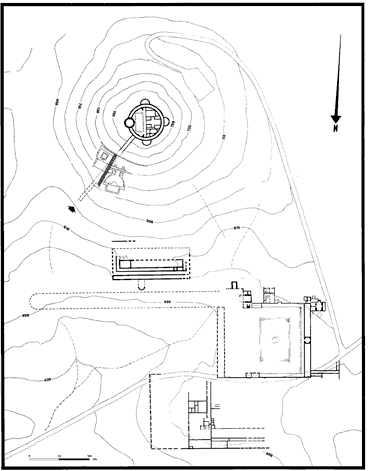
1a. Plan of Greater Herodium, including the new excavations (Courtesy Herodium Expedition).
Benny Arubas
1b. The structures on the summit and on the hill slopes, including the water cisterns (Courtesy Herodium Expedition).
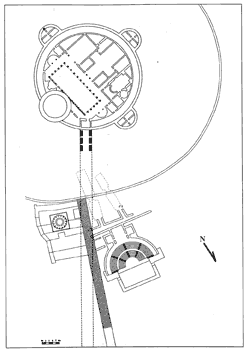
2. General view of the mausoleum podium, looking south (B. Arubas).

3. Reconstructed views indicating that the mausoleum could barely have been seen from the northern area of the pool garden in Lower Herodium (a, b) and from The Course (c) (B. Arubas).
3a. 
3b. 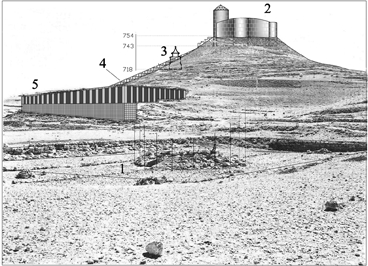
3c. 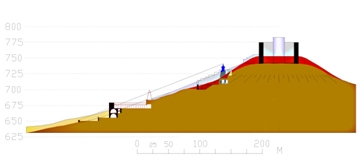
4. View of the later stairway built over the irrigation basin of the mausoleum. 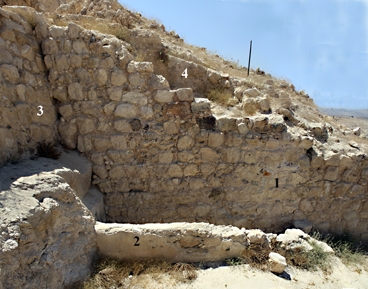
a. Looking west. 1. Later stairway; 2. Irrigation basin; 3. Southern wall of the burial lot.
4. Earlier stairway (B. Arubas).
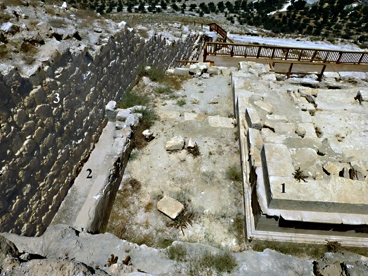
b. 1. Mausoleum podium; 2. Irrigation basin; 3. Later stairway (J. Patrich).
5. A new proposal for locating the burial chamber in the depths of the hill, with a tunnel passage leading in from the “Lower Palace”, presented here as a decorative forecourt (B. Arubas).

Notes
[1] E. Netzer, The Main Features of Herod’s Architecture, in: Rozenberg and Mevorah (eds.), Herod the Great: The King’s Final Journey, Jerusalem 2013, pp. 163–165; idem. The Architecture of Herod, the Great Builder, Tübingen 2006, pp. 294–300.
[2] For other scholars questioning the mausoleum as Herod’s tomb see: D.M. Jacobson, Has Herod’s Place of Burial been Found? Palestine Exploration Quarterly, 139 (2007), pp.147–148; G. Foerster, The Sarcophagi from the Mausoleum Unearthed at Herodium, in: Rozenberg and Mevorah (eds.), supra, note 1, pp. 267–277; and more recently: H. Shankes, Was Herod’s Tomb Really Found?” Biblical Archaeology Review 40/3 (2014), pp. 40-48.
Comments (2)
Has the real mausoleum of the Maccabees in Modi'in been found?
